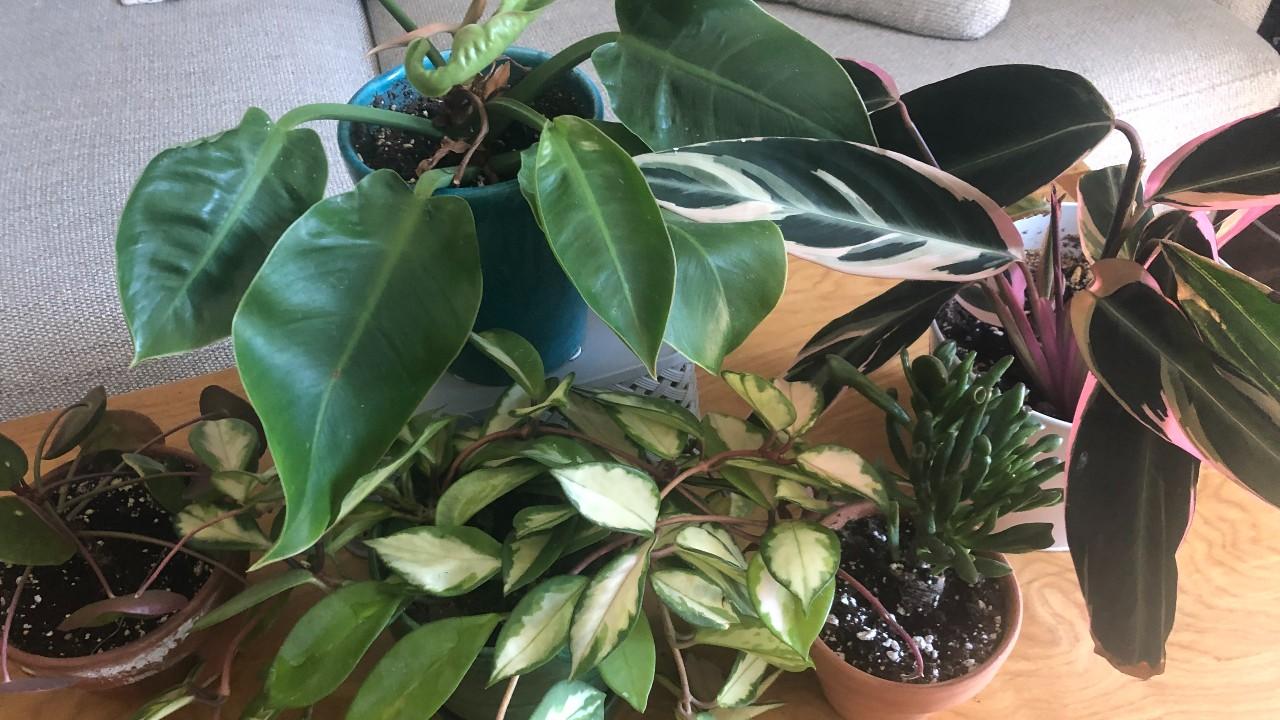
Indoor plants. Photo: J. Burchfield
Sustainable Gardening
- Saving and sharing seeds is a fun way to collaborate with other gardeners, make good use of what your garden provides naturally, and save money. The last Saturday in January is National Seed Swap Day. In Maryland, seed exchanges are held by some local Master Gardener programs, libraries, and public gardens.
- Cut invasive English ivy vines that are growing up on tree trunks. These vines are easier to spot during the winter months when shade trees are bare.
Trees & Shrubs
-
If you purchased holiday decorations made from Boxwood branches, do not dispose of them in your compost. They can potentially be a carriers of boxwood blight and spread it to healthy boxwoods in the landscape.
-
Problem tree branches (hanging very low or storm-damaged), may be removed as needed. It is not necessary to wait until spring for this type of pruning.
-
Heavy snow and ice loads can damage shrubs. Using a broom, you can push gently upwards on limbs to shake and dislodge snow from branches to prevent breakage. But oftentimes, bent or weighed-down branches will spring back after the snow/ice melts.
-
Do not handle the hairy poison ivy vines wrapped around trees. Be aware that the offending oil of poison ivy, urushiol, is active and can produce symptoms during any time of the year. Be very careful not to bring firewood into the house with poison ivy vines attached.
Edible plants
- Fruit in Your Future? Order fruit plants online in January and February for early spring planting. Strawberries, blackberries, and figs are easier to maintain without pesticides compared to apples, pears, and peaches.
- Fireblight damage on established apple and pear trees should be pruned out during the coldest periods in December or January. This will lessen the chance of spreading this bacterial infection.
Pests
-
Be on the lookout for spotted lanternfly egg masses on the trunks of trees and other surfaces. Scape them off and discard them.
-
Remove and destroy bagworm bags from affected trees especially if seen on evergreens.
Starting Seeds
- Try winter sowing! Some seeds can be planted outdoors now in recycled plastic containers. This is a good method to start native plant seeds that require a cold period before germination. Learn about winter sowing on our blog or watch a video training by the Charles County Master Gardeners.
- Avoid the temptation to start vegetable garden seeds indoors too soon. Check seed packets for detailed information and refer to our vegetable planting calendar for guidance on starting seeds indoors.
Indoor plant and insect tips
Ornamental plants

-
Be careful not to overwater houseplants. Most houseplants should be watered only when the top of the growing medium begins to dry out.
-
Cut back or stop fertilizing houseplants unless they are grown under supplemental lighting.
-
Several species of soft scale insects appear as brown bumps on leaves and stems and can be managed with a light horticultural oil spray labeled for houseplants.
-
Did you receive an amaryllis for the holidays? Keep it in a sunny window. After it is done flowering, the plant will produce leaves and with proper care can rebloom.
Edible plants
-
Try growing greens indoors using hydroponics.
-
Indoor herb plants benefit from daily misting and full sun windows.
Pests
-
Indian meal moths are a common problem of grains and grain products, cereals, bird seeds, dried pet food, etc. You may see adult moths flying, larvae crawling or webbing. Always check bulk foods prior to purchase for signs of meal moth infestation.
-
Don’t store firewood inside your home. Only bring in enough to burn at one time. Bark and other wood-boring beetles may emerge inside the home.